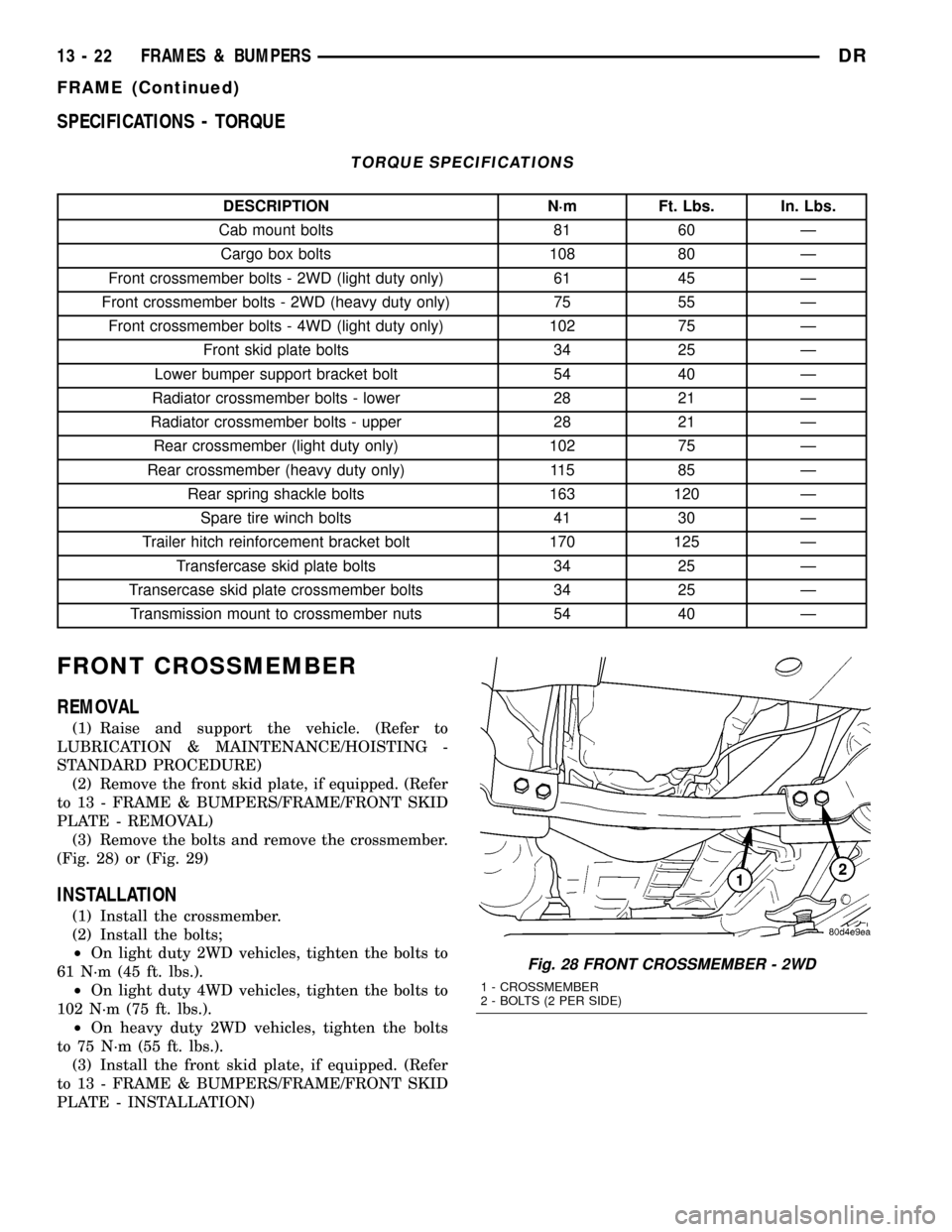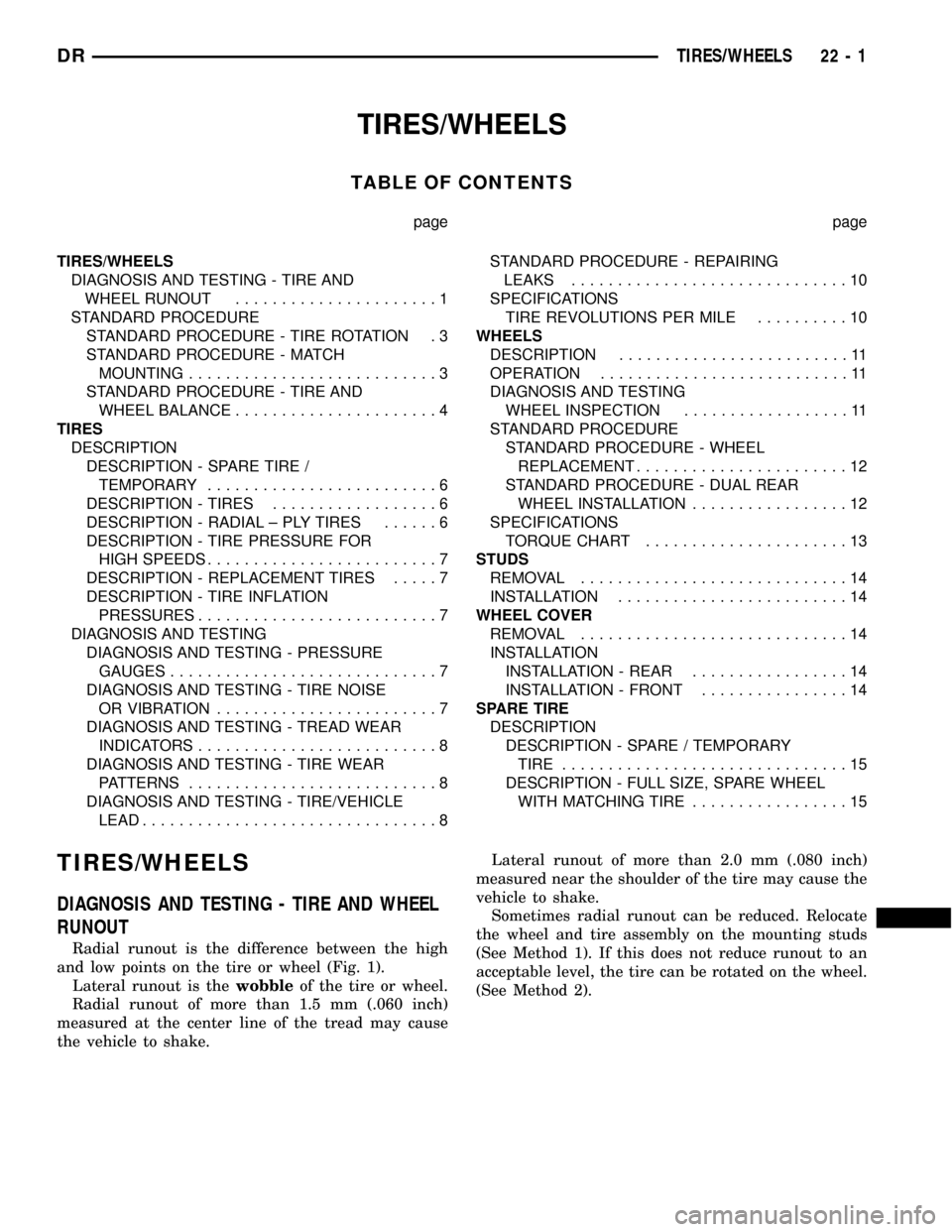1998 DODGE RAM 1500 spare tire
[x] Cancel search: spare tirePage 1556 of 2627

STANDARD PROCEDURE - REAR FRAME
H-SECTION REPLACEMENT
CAUTION: This procedure is designed to replace
the H-section/spare tire support located at the rear
of the frame assembly. Prior to any cutting, the
vehicle must be mounted on the appropriate frame
repair equipment (ªframe rackº), checked with three
dimensional measuring equipment, and the neces-
sary pull corrections made. If damage remains in
the frame beyond the area covered by this service
part after the pull, the frame must be replaced in its
entirety.
(1) Before proceding with this repair procedure
review the required service warnings and precau-
tions. (Refer to 13 - FRAME & BUMPERS/FRAME -
WARNING)
(2) Disconnect and isolate the battery negative
cable.
(3) Remove the cargo box. (Refer to 23 - BODY/EX-
TERIOR/CARGO BOX - REMOVAL)
(4) Remove the trailer hitch. (Refer to 13 - FRAME
& BUMPERS/FRAME/TRAILER HITCH -
REMOVAL)
(5) Raise and support the frame so the tires are off
floor.(6) Remove the shock absorbers. (Refer to 2 - SUS-
PENSION/REAR/SHOCK - REMOVAL)
(7) Remove the rear leaf spring shackle bolts and
let the axle rest on the ground. (Fig. 20)
(8) Remove the spare wheel.
Fig. 19 ENGINE COMPARTMENT/FRONT STRUCTURE
Fig. 20 REAR SPRING
1 - SPRING SHACKLE
2 - LEAF SPRING EYE BOLT/NUT
3 - REAR LEAF SPRING
DRFRAMES & BUMPERS 13 - 13
FRAME (Continued)
Page 1557 of 2627

(9) Remove the clip and remove the spare tire
winch tube. (Fig. 21)
(10) Remove the bolts and remove the spare tire
winch. (Fig. 22)
(11) Position the wire harness forward of the work
area.
CAUTION: Do not use any flame or plasma cutting
equipment to cut the frame in this procedure. The
inaccurate and high temperatures achieved during
flame or plasma cutting will change the metal char-
acteristics and may weaken the frame and/or repair
location.(12) Carefully remove the H-section welds using a
grinder or equivalent tool.
(13) Remove the H-section and clean any remain-
ing welds from the frame.
(14) Trial fit the replacement part.
(15) Remove all e-coat from within 25 mm (1.0 in.)
of the weld area.
(16) Using the appropriate measuring equipment,
position the replacement part and verify correct posi-
tioning in all three (X,Y, and Z) planes of space.
(Refer to 13 - FRAME & BUMPERS/FRAME - SPEC-
IFICATIONS - FRAME DIMENSIONS)
CAUTION: Shield the surrounding area and compo-
nents from exposure to the welding spatter and
heat.
(17) Weld the replacement H-section into position.
The welding should be performed in a skip (stitch)
type method to minimize the heat buildup following
I-CAR or the American Welding Society welding pro-
cedures and utilizing the process specifications at the
end of this section. (Refer to 13 - FRAME &
BUMPERS/FRAME - SPECIFICATIONS - WELD-
ING)
(18) Dress the welded area and apply corrosion
resistant coatings inside and out.
(a) Inside the rail, inject a creeping wax based
rust inhibitor compound through the existing holes
in the frame ensuring 100% coverage including the
mating face between the frame and replacement
H-section.
(b) Apply a durable top coat to the outside of the
repair area.
(19) Position the wiring harness back.
CAUTION: Inspect the tire winch assembly for dam-
age. If any one or more of the following are evident,
replace the winch assembly.
²Indications of cracked or bulging plastic.
²Housing flanges are bent or cracked.
²If winch was loose before repair.
(20) Install the spare tire winch and install the
bolts. (Fig. 22)
(21) Tighten the bolts to 41 N´m (30 ft. lbs.).
(22) Install the spare tire winch tube and install
the clip. (Fig. 21)
(23) Install the spare tire.
CAUTION: Check operation of the spare tire winch
by manipulating it up and down. If the winch binds
or jambs, replace the winch assembly.
(24) Lift the axle into position and install the rear
shackle bolts. (Fig. 20)
(25) Tighten the bolts to 163 N´m (120 ft. lbs.).
Fig. 21 SPARE TIRE WINCH TUBE
1 - SPARE TIRE WINCH ASSEMBLY
2 - HAIR PIN CLIP
3 - WINCH TUBE
4 - H-SECTION/SPARE WHEEL SUPPORT
Fig. 22 SPARE TIRE WINCH ASSEMBLY
1 - SPARE TIRE WINCH ASSEMBLY
2 - BOLTS
3 - RETAINER BRACKET
4 - H-SECTION/SPARE WHEEL SUPPORT
13 - 14 FRAMES & BUMPERSDR
FRAME (Continued)
Page 1565 of 2627

SPECIFICATIONS - TORQUE
TORQUE SPECIFICATIONS
DESCRIPTION N´m Ft. Lbs. In. Lbs.
Cab mount bolts 81 60 Ð
Cargo box bolts 108 80 Ð
Front crossmember bolts - 2WD (light duty only) 61 45 Ð
Front crossmember bolts - 2WD (heavy duty only) 75 55 Ð
Front crossmember bolts - 4WD (light duty only) 102 75 Ð
Front skid plate bolts 34 25 Ð
Lower bumper support bracket bolt 54 40 Ð
Radiator crossmember bolts - lower 28 21 Ð
Radiator crossmember bolts - upper 28 21 Ð
Rear crossmember (light duty only) 102 75 Ð
Rear crossmember (heavy duty only) 115 85 Ð
Rear spring shackle bolts 163 120 Ð
Spare tire winch bolts 41 30 Ð
Trailer hitch reinforcement bracket bolt 170 125 Ð
Transfercase skid plate bolts 34 25 Ð
Transercase skid plate crossmember bolts 34 25 Ð
Transmission mount to crossmember nuts 54 40 Ð
FRONT CROSSMEMBER
REMOVAL
(1) Raise and support the vehicle. (Refer to
LUBRICATION & MAINTENANCE/HOISTING -
STANDARD PROCEDURE)
(2) Remove the front skid plate, if equipped. (Refer
to 13 - FRAME & BUMPERS/FRAME/FRONT SKID
PLATE - REMOVAL)
(3) Remove the bolts and remove the crossmember.
(Fig. 28) or (Fig. 29)
INSTALLATION
(1) Install the crossmember.
(2) Install the bolts;
²On light duty 2WD vehicles, tighten the bolts to
61 N´m (45 ft. lbs.).
²On light duty 4WD vehicles, tighten the bolts to
102 N´m (75 ft. lbs.).
²On heavy duty 2WD vehicles, tighten the bolts
to 75 N´m (55 ft. lbs.).
(3) Install the front skid plate, if equipped. (Refer
to 13 - FRAME & BUMPERS/FRAME/FRONT SKID
PLATE - INSTALLATION)
Fig. 28 FRONT CROSSMEMBER - 2WD
1 - CROSSMEMBER
2 - BOLTS (2 PER SIDE)
13 - 22 FRAMES & BUMPERSDR
FRAME (Continued)
Page 2280 of 2627

TIRES/WHEELS
TABLE OF CONTENTS
page page
TIRES/WHEELS
DIAGNOSIS AND TESTING - TIRE AND
WHEEL RUNOUT......................1
STANDARD PROCEDURE
STANDARD PROCEDURE - TIRE ROTATION . 3
STANDARD PROCEDURE - MATCH
MOUNTING...........................3
STANDARD PROCEDURE - TIRE AND
WHEEL BALANCE......................4
TIRES
DESCRIPTION
DESCRIPTION - SPARE TIRE /
TEMPORARY.........................6
DESCRIPTION - TIRES..................6
DESCRIPTION - RADIAL ± PLY TIRES......6
DESCRIPTION - TIRE PRESSURE FOR
HIGH SPEEDS.........................7
DESCRIPTION - REPLACEMENT TIRES.....7
DESCRIPTION - TIRE INFLATION
PRESSURES..........................7
DIAGNOSIS AND TESTING
DIAGNOSIS AND TESTING - PRESSURE
GAUGES.............................7
DIAGNOSIS AND TESTING - TIRE NOISE
OR VIBRATION........................7
DIAGNOSIS AND TESTING - TREAD WEAR
INDICATORS..........................8
DIAGNOSIS AND TESTING - TIRE WEAR
PATTERNS...........................8
DIAGNOSIS AND TESTING - TIRE/VEHICLE
LEAD................................8STANDARD PROCEDURE - REPAIRING
LEAKS..............................10
SPECIFICATIONS
TIRE REVOLUTIONS PER MILE..........10
WHEELS
DESCRIPTION.........................11
OPERATION...........................11
DIAGNOSIS AND TESTING
WHEEL INSPECTION..................11
STANDARD PROCEDURE
STANDARD PROCEDURE - WHEEL
REPLACEMENT.......................12
STANDARD PROCEDURE - DUAL REAR
WHEEL INSTALLATION.................12
SPECIFICATIONS
TORQUE CHART......................13
STUDS
REMOVAL.............................14
INSTALLATION.........................14
WHEEL COVER
REMOVAL.............................14
INSTALLATION
INSTALLATION - REAR.................14
INSTALLATION - FRONT................14
SPARE TIRE
DESCRIPTION
DESCRIPTION - SPARE / TEMPORARY
TIRE...............................15
DESCRIPTION - FULL SIZE, SPARE WHEEL
WITH MATCHING TIRE.................15
TIRES/WHEELS
DIAGNOSIS AND TESTING - TIRE AND WHEEL
RUNOUT
Radial runout is the difference between the high
and low points on the tire or wheel (Fig. 1).
Lateral runout is thewobbleof the tire or wheel.
Radial runout of more than 1.5 mm (.060 inch)
measured at the center line of the tread may cause
the vehicle to shake.Lateral runout of more than 2.0 mm (.080 inch)
measured near the shoulder of the tire may cause the
vehicle to shake.
Sometimes radial runout can be reduced. Relocate
the wheel and tire assembly on the mounting studs
(See Method 1). If this does not reduce runout to an
acceptable level, the tire can be rotated on the wheel.
(See Method 2).
DRTIRES/WHEELS 22 - 1
Page 2282 of 2627

STANDARD PROCEDURE
STANDARD PROCEDURE - TIRE ROTATION
Tires on the front and rear axles operate at differ-
ent loads and perform different steering, driving, and
braking functions. For these reasons, the tires wear
at unequal rates. They may also develop irregular
wear patterns. These effects can be reduced by rotat-
ing the tires according to the maintenance schedule
in the Owners Manual. This will improve tread life,
traction and maintain a smooth quiet ride.
The recommended method of tire rotation is (Fig.
4) & (Fig. 5). Other methods can be used, but may
not provide the same tire longevity benefits.
CAUTION: 3500 Dual rear tires have a new tire rota-
tion pattern. This is to accommodate the asymmet-
rical design of the ON/OFF road tires and the use of
the outlined white letter (OWL) tires. When replac-
ing a flat, the spare tire may have to be remounted
on the rim or installed at a different location to
maintain the correct placement of the asymmetrical
design or the (OWL).
STANDARD PROCEDURE - MATCH MOUNTING
Wheels and tires are match mounted at the factory.
This means that the high spot of the tire is matched
to the low spot on the wheel rim. Each are marked
with a bright colored temporary label on the out-
board surface for alignment. The wheel is also
marked permanently on the inside of the rim in the
tire well. This permanent mark may be a paint dot
or line, a permanent label or a stamped impression
such as an X. An optional location mark is a small
spherical indentation on the vertical face of the out-
board flange on some non styled base steel wheels.
The tire must be removed to locate the permanent
mark on the inside of the wheel.
Before dismounting a tire from its wheel, a refer-
ence mark should be placed on the tire at the valve
stem location. This reference will ensure that it is
remounted in the original position on the wheel.
(1) Remove the tire and wheel assembly from the
vehicle and mount on a service dynamic balance
machine.
(2) Measure the total runout on the center of the
tire tread rib with a dial indicator. Record the indi-
cator reading. Mark the tire to indicate the high spot.
Place a mark on the tire at the valve stem location
(Fig. 6).
Fig. 4 TIRE ROTATION PATTERN - SINGLE REAR
WHEEL (SRW)
Fig. 5 TIRE ROTATION PATTERN - DUAL REAR
WHEELS (DRW)
Fig. 6 First Measurement On Tire
1 - REFERENCE MARK
2 - 1ST MEASUREMENT HIGH SPOT MARK TIRE AND RIM
3 - WHEEL
4 - VALVE STEM
DRTIRES/WHEELS 22 - 3
TIRES/WHEELS (Continued)
Page 2285 of 2627

TIRES
DESCRIPTION
DESCRIPTION - SPARE TIRE / TEMPORARY
The temporary spare tire is designed for emer-
gency use only. The original tire should be repaired
or replaced at the first opportunity, then reinstalled.
Do not exceed speeds of 50 M.P.H. when using the
temporary spare tire. Refer to Owner's Manual for
complete details.
DESCRIPTION - TIRES
Tires are designed and engineered for each specific
vehicle. They provide the best overall performance
for normal operation. The ride and handling charac-
teristics match the vehicle's requirements. With
proper care they will give excellent reliability, trac-
tion, skid resistance, and tread life.
Driving habits have more effect on tire life than
any other factor. Careful drivers will obtain in most
cases, much greater mileage than severe use or care-
less drivers. A few of the driving habits which will
shorten the life of any tire are:
²Rapid acceleration
²Severe brake applications
²High speed driving
²Excessive speeds on turns
²Striking curbs and other obstacles
Radial-ply tires are more prone to irregular tread
wear. It is important to follow the tire rotation inter-
val shown in the section on Tire Rotation, (Refer to
22 - TIRES/WHEELS - STANDARD PROCEDURE).
This will help to achieve a greater tread life.
TIRE IDENTIFICATION
Tire type, size, aspect ratio and speed rating are
encoded in the letters and numbers imprinted on the
side wall of the tire. Refer to the chart to decipher
the tire identification code (Fig. 11).
Performance tires have a speed rating letter after
the aspect ratio number. The speed rating is not
always printed on the tire sidewall. These ratings
are:
²Qup to 100 mph
²Rup to 106 mph
²Sup to 112 mph
²Tup to 118 mph
²Uup to 124 mph
²Hup to 130 mph
²Vup to 149 mph
²Zmore than 149 mph (consult the tire manu-
facturer for the specific speed rating)An All Season type tire will have eitherM+S,M
&SorM±S(indicating mud and snow traction)
imprinted on the side wall.
TIRE CHAINS
Tire snow chains may be used oncertainmodels.
Refer to the Owner's Manual for more information.
DESCRIPTION - RADIAL ± PLY TIRES
Radial-ply tires improve handling, tread life and
ride quality, and decrease rolling resistance.
Radial-ply tires must always be used in sets of
four. Under no circumstances should they be used on
the front only. They may be mixed with temporary
spare tires when necessary. A maximum speed of 50
MPH is recommended while a temporary spare is in
use.
Radial-ply tires have the same load-carrying capac-
ity as other types of tires of the same size. They also
use the same recommended inflation pressures.
The use of oversized tires, either in the front or
rear of the vehicle, can cause vehicle drive train fail-
ure. This could also cause inaccurate wheel speed
signals when the vehicle is equipped with Anti-Lock
Brakes.
The use of tires from different manufactures on the
same vehicle is NOT recommended. The proper tire
pressure should be maintained on all four tires.
Fig. 11 Tire Identification
22 - 6 TIRES/WHEELSDR
Page 2294 of 2627

(2) Seat on side of the wheel skin's wire retainer
on to the wheel.
(3) Using a rubber mallet, strike the opposite side
of the wheel skin until the skin is properly seated.
NOTE: The wheel skin and the hub cap are fully
seated when there is a consistant gap between the
skin/ cap and the wheel.
(4) Tug on the hub cap/wheel skin to ensure that
they are properly installed.
SPARE TIRE
DESCRIPTION
DESCRIPTION - SPARE / TEMPORARY TIRE
The temporary spare tire is designed for emer-
gency use only. The original tire should be repairedor replaced at the first opportunity, then reinstalled.
Do not exceed speeds of 50 M.P.H. when using the
temporary spare tire. Refer to Owner's Manual for
complete details.
DESCRIPTION - FULL SIZE, SPARE WHEEL
WITH MATCHING TIRE
The spare is a full usage wheel with a matching
tire, It can be used within the (posted legal) speed
limits or distance limitations as of the rest of the
vehicles four tires. Refer to Owner's Manual for com-
plete details.
DRTIRES/WHEELS 22 - 15
WHEEL COVER (Continued)
Page 2601 of 2627

FRONT SERVO - DESCRIPTION.........21-208
FRONT SERVO - DISASSEMBLY........21-209
FRONT SERVO - INSPECTION..........21-209
FRONT SERVO - OPERATION..........21-208
FRONT SKID PLATE - INSTALLATION.....13-23
FRONT SKID PLATE - REMOVAL.........13-23
FRONT SUSPENSION - DESCRIPTION,
GEAR - INDEPENDENT................19-17
FRONT SUSPENSION - INSTALLATION,
GEAR - INDEPENDENT................19-18
FRONT SUSPENSION - REMOVAL, GEAR
- INDEPENDENT.....................19-17
FRONT SUSPENSION, SPECIAL TOOLS....2-12
FRONT TOW HOOK ASSEMBLY -
INSTALLATION.......................13-23
FRONT TOW HOOK ASSEMBLY -
REMOVAL..........................13-23
FRONT WHEEL SPEED SENSOR -
DESCRIPTION........................5-47
FRONT WHEEL SPEED SENSOR -
INSTALLATION........................5-48
FRONT WHEEL SPEED SENSOR -
OPERATION..........................5-47
FRONT WHEEL SPEED SENSOR -
REMOVAL...........................5-48
FRONT WHEELHOUSE SPLASH SHIELD -
INSTALLATION.......................23-41
FRONT WHEELHOUSE SPLASH SHIELD -
REMOVAL..........................23-41
FUEL CONTROL ACTUATOR -
DESCRIPTION.......................14-74
FUEL CONTROL ACTUATOR -
OPERATION.........................14-74
FUEL CONTROL ACTUATOR - REMOVAL . . . 14-74
FUEL DELIVERY - GAS - DESCRIPTION....14-1
FUEL DELIVERY - GAS - OPERATION......14-2
FUEL DRAIN CIRCUIT - OPERATION......14-67
FUEL FILL DOOR - INSTALLATION.......23-39
FUEL FILL DOOR - REMOVAL...........23-39
FUEL FILLER CAP - DESCRIPTION.......25-13
FUEL FILLER CAP - OPERATION.........25-13
FUEL FILTER - STANDARD
PROCEDURES, WATER DRAINING AT.....14-47
FUEL FILTER / WATER SEPARATOR -
DESCRIPTION.......................14-50
FUEL FILTER / WATER SEPARATOR -
INSTALLATION.......................14-50
FUEL FILTER / WATER SEPARATOR -
OPERATION.........................14-50
FUEL FILTER / WATER SEPARATOR -
REMOVAL..........................14-50
FUEL FILTER/PRESSURE REGULATOR -
DESCRIPTION........................14-5
FUEL FILTER/PRESSURE REGULATOR -
OPERATION..........................14-6
FUEL GAUGE - DESCRIPTION...........8J-26
FUEL GAUGE - OPERATION.............8J-26
FUEL HEATER - DESCRIPTION..........14-51
FUEL HEATER - DIAGNOSIS AND
TESTING...........................14-52
FUEL HEATER - OPERATION............14-51
FUEL HEATER RELAY - DESCRIPTION....14-52
FUEL HEATER RELAY - INSTALLATION....14-53
FUEL HEATER RELAY - OPERATION......14-52
FUEL HEATER RELAY - REMOVAL........14-52
FUEL INDICATOR - DESCRIPTION, LOW . . . 8J-30
FUEL INDICATOR - OPERATION, LOW.....8J-30
FUEL INJECTION PUMP - DESCRIPTION . . 14-53
FUEL INJECTION PUMP - INSTALLATION . . 14-55
FUEL INJECTION PUMP - OPERATION....14-53
FUEL INJECTION PUMP - REMOVAL......14-54
FUEL INJECTION PUMP TIMING -
DIAGNOSIS AND TESTING.............14-53
FUEL INJECTOR - DESCRIPTION....14-26,14-74
FUEL INJECTOR - INSTALLATION........14-77
FUEL INJECTOR - OPERATION.....14-26,14-74
FUEL INJECTOR - REMOVAL............14-75
FUEL INJECTOR FIRING ORDER, DIESEL . . 14-48
FUEL INJECTOR RAIL - DESCRIPTION....14-78
FUEL INJECTOR RAIL - INSTALLATION....14-78
FUEL INJECTOR RAIL - OPERATION
......14-78
FUEL INJECTOR RAIL - REMOVAL
.......14-78
FUEL LEVEL SENDING UNIT / SENSOR -
DESCRIPTION
...................14-57,14-6
FUEL LEVEL SENDING UNIT / SENSOR -
INSTALLATION
........................14-7
FUEL LEVEL SENDING UNIT / SENSOR -
OPERATION
.....................14-57,14-6FUEL LEVEL SENDING UNIT / SENSOR -
REMOVAL...........................14-7
FUEL LINE LEAKS - DIAGNOSIS AND
TESTING, HIGH-PRESSURE.............14-58
FUEL LINES - DESCRIPTION........14-57,14-7
FUEL LINES - INSTALLATION...........14-60
FUEL LINES - OPERATION..............14-57
FUEL LINES - REMOVAL...............14-58
FUEL PRESSURE LIMITING VALVE -
DESCRIPTION.......................14-61
FUEL PRESSURE LIMITING VALVE -
INSTALLATION.......................14-61
FUEL PRESSURE LIMITING VALVE -
OPERATION.........................14-61
FUEL PRESSURE LIMITING VALVE -
REMOVAL..........................14-61
FUEL PRESSURE SENSOR -
DESCRIPTION.......................14-60
FUEL PRESSURE SENSOR -
INSTALLATION.......................14-61
FUEL PRESSURE SENSOR - OPERATION . . 14-60
FUEL PRESSURE SENSOR - REMOVAL....14-60
FUEL PUMP - DESCRIPTION............14-11
FUEL PUMP - OPERATION.............14-11
FUEL PUMP MODULE - DESCRIPTION....14-11
FUEL PUMP MODULE - INSTALLATION . . . 14-12
FUEL PUMP MODULE - OPERATION......14-11
FUEL PUMP MODULE - REMOVAL.......14-12
FUEL PUMP RELAY - DESCRIPTION......14-27
FUEL PUMP RELAY - INSTALLATION.....14-28
FUEL PUMP RELAY - OPERATION........14-27
FUEL PUMP RELAY - REMOVAL.........14-28
FUEL PUMP RELAYS - DIAGNOSIS AND
TESTING, ASD........................8I-5
FUEL RAIL - DESCRIPTION.............14-12
FUEL RAIL - INSTALLATION............14-15
FUEL RAIL - OPERATION...............14-12
FUEL RAIL - REMOVAL................14-13
FUEL REQUIREMENTS - DIESEL ENGINE
- DESCRIPTION........................0-1
FUEL SENSOR - DESCRIPTION, WATER
IN ................................14-66
FUEL SENSOR - OPERATION, WATER IN . . 14-66
FUEL SENSOR - REMOVAL, WATER IN....14-66
FUEL SYSTEM - DESCRIPTION, DIESEL . . . 14-45
FUEL SYSTEM - DIESEL ENGINE -
TORQUE............................14-48
FUEL SYSTEM - EXCEPT DIESEL -
TORQUE............................14-3
FUEL SYSTEM PARTS - STANDARD
PROCEDURES, CLEANING..............14-47
FUEL SYSTEM PRESSURE RELEASE -
STANDARD PROCEDURE................14-2
FUEL SYSTEM PRESSURE,
SPECIFICATIONS......................14-3
FUEL SYSTEM PRIMING - STANDARD
PROCEDURE........................14-47
FUEL SYSTEM, SPECIAL TOOLS..........14-5
FUEL SYSTEM, SPECIAL TOOLS -
DIESEL............................14-49
FUEL TANK - DESCRIPTION............14-17
FUEL TANK - OPERATION..............14-17
FUEL TANK MODULE - DESCRIPTION.....14-63
FUEL TANK MODULE - INSTALLATION....14-64
FUEL TANK MODULE - OPERATION......14-63
FUEL TANK MODULE - REMOVAL........14-63
FUEL TRANSFER PUMP - DESCRIPTION . . 14-64
FUEL TRANSFER PUMP - INSTALLATION . . 14-65
FUEL TRANSFER PUMP - OPERATION....14-64
FUEL TRANSFER PUMP - REMOVAL......14-64
FULL SIZE, SPARE WHEEL WITH
MATCHING TIRE - DESCRIPTION........22-15
FUNCTIONS - DESCRIPTION, CIRCUIT . . 8W-01-6
FUSE - DESCRIPTION, IOD...........8W-97-6
FUSE - INSTALLATION, IOD..........8W-97-7
FUSE - OPERATION, IOD.............8W-97-6
FUSE - REMOVAL, IOD..............8W-97-7
FUSES POWERING SEVERAL LOADS -
STANDARD PROCEDURE, TESTING
FOR A SHORT TO GROUND ON......8W-01-10
GAP AND FLUSH - SPECIFICATIONS......23-95
GAS ENGINE - DIAGNOSIS AND TESTING
. . 11-4
GAS ENGINE - INSTALLATION
...........19-26
GAS ENGINE - REMOVAL
..............19-25
GAS ENGINES - CLEANING, RADIATOR
FAN
................................7-34
GAS ENGINES - DESCRIPTION, COOLANT
RECOVERY CONTAINER
................7-33GAS ENGINES - INSPECTION, RADIATOR
FAN ................................7-34
GAS ENGINES - INSTALLATION,
COOLANT RECOVERY CONTAINER........7-33
GAS ENGINES - INSTALLATION,
RADIATOR FAN.......................7-34
GAS ENGINES - OPERATION, COOLANT
RECOVERY CONTAINER................7-33
GAS ENGINES - REMOVAL, COOLANT
RECOVERY CONTAINER................7-33
GAS ENGINES - REMOVAL, RADIATOR
FAN ................................7-33
GAS ENGINES - STANDARD
PROCEDURE, DRAINING COOLING
SYSTEM - ALL........................7-17
GAS ENGINES - STANDARD
PROCEDURE, REFILLING COOLING
SYSTEM - ALL........................7-18
GASKET - DIAGNOSIS AND TESTING,
CYLINDER HEAD......................9-21
GASKET FAILURE - DIAGNOSIS AND
TESTING, CYLINDER HEAD.............9-199
GASKET SELECTION - STANDARD
PROCEDURE, HEAD...................9-281
GASKET SURFACE PREPARATION -
STANDARD PROCEDURE, ENGINE........9-10
GASKETS AND SEALERS - STANDARD
PROCEDURE, FORM-IN-PLACE . . . 9-239,9-9,9-94
GAUGE - DESCRIPTION, ENGINE
TEMPERATURE......................8J-24
GAUGE - DESCRIPTION, FUEL...........8J-26
GAUGE - DESCRIPTION, OIL PRESSURE . . 8J-33
GAUGE - DESCRIPTION, VOLTAGE.......8J-42
GAUGE - OPERATION, ENGINE
TEMPERATURE......................8J-24
GAUGE - OPERATION, FUEL............8J-26
GAUGE - OPERATION, OIL PRESSURE....8J-33
GAUGE - OPERATION, VOLTAGE.........8J-43
GAUGES - DIAGNOSIS AND TESTING,
PRESSURE..........................22-7
GAUGES INDICATOR - DESCRIPTION,
CHECK.............................8J-21
GAUGES INDICATOR - OPERATION,
CHECK.............................8J-21
GEAR - DESCRIPTION, CRANKSHAFT.....9-273
GEAR - INDEPENDENT FRONT
SUSPENSION - DESCRIPTION...........19-17
GEAR - INDEPENDENT FRONT
SUSPENSION - INSTALLATION..........19-18
GEAR - INDEPENDENT FRONT
SUSPENSION - REMOVAL..............19-17
GEAR - INSTALLATION................9-273
GEAR - INSTALLATION, PINION
GEAR/RING......................3-51,3-77
GEAR - LINK/COIL - DESCRIPTION.......19-20
GEAR - LINK/COIL - INSTALLATION......19-21
GEAR - LINK/COIL - OPERATION........19-20
GEAR - LINK/COIL - REMOVAL..........19-20
GEAR - REMOVAL....................9-273
GEAR - REMOVAL, PINION GEAR/RING....3-49,
3-75
GEAR HOUSING - INSTALLATION........9-300
GEAR HOUSING - REMOVAL............9-299
GEAR HOUSING COVER - INSTALLATION . . 9-301
GEAR HOUSING COVER - REMOVAL
.....9-301
GEAR INPUT SHAFT SEAL -
INSTALLATION, STEERING
.............19-29
GEAR INPUT SHAFT SEAL - REMOVAL,
STEERING
..........................19-27
GEAR SELECTOR INDICATOR -
DESCRIPTION
.......................8J-27
GEAR SELECTOR INDICATOR -
OPERATION
.........................8J-27
GEAR SHIFT LEVER - INSTALLATION
.....19-12
GEAR SHIFT LEVER - REMOVAL
.........19-12
GEAR, SPECIAL TOOLS - POWER
STEERING
..........................19-23
GEAR, SPECIFICATIONS - POWER
STEERING
..........................19-22
GEAR TO COOLER - INSTALLATION,
RETURN HOSE
.................19-44,19-45
GEAR TO COOLER - REMOVAL, RETURN
HOSE
.........................19-44,19-45
GEAR/RING GEAR - INSTALLATION,
PINION
.........................3-51,3-77
GEAR/RING GEAR - REMOVAL, PINION
....3-49,
3-75
14 INDEXDR
Description Group-Page Description Group-Page Description Group-Page